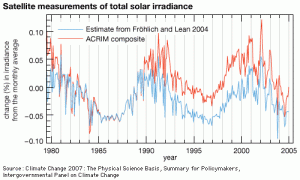Why Not Connect The Dots? Mars, Earth and The Sun
By D.K. Matai

NASA scientists say that Mars has warmed by about 0.5°C since the 1970s. This is similar to the warming experienced on Earth over approximately the same period. Given that there is no known life on Mars, simultaneous warming on Mars and Earth suggests that our planetʼs recent climate changes may have a more natural cause and a less man-made cause.
In 2005, data from NASA’s Mars Global Surveyor and Odyssey missions revealed that the carbon dioxide “ice caps” near Mars’s south pole had been diminishing for three summers in a row. At the same time, Earth was experiencing rapid warming, which some climate scientists said was due to humans pumping vast amounts of carbon dioxide and other greenhouse gases into the atmosphere.
Why did Mars appear to be enjoying more mild and balmy temperatures like Earth at the same time?
Mars, Earth and The Sun
The parallel global warmings — observed by NASA simultaneously on Mars and on Earth in the latter part of the 20th century and first few years of the 21st century — can perhaps be a direct consequence of the effect of the one same factor: a change in Total Solar Irradiance (TSI). Changes in the sun’s total heat, light and other electromagnetic output may be able to account for most of the climate changes we see on both planets.
Melting of Mars “ice caps” hints at solar, not human, interference for planetary warming.
Habibullo Abdussamatov, head of Space Research at St Petersburg’s Pulkovo Astronomical Observatory in Russia, says the Mars data is evidence that the current global climate change on Earth is being caused by changes in the sun. Pulkovo AO, founded in 1839, is at the pinnacle of Russia’s space-oriented scientific establishment and is one of the world’s best equipped observatories.

Total Solar Irradiance (TSI) began to drop in the 2000s and scientists have observed its effects on the recent cooling that is occurring on the upper layers of the world’s oceans. This suggests the Earth may have hit its temperature ceiling. The 13+ years elongated solar cycle (2006-2009?) is likely to usher in a protracted cooling period over the coming decades, given the previous patterns.
The minimum in solar irradiance reaching Earth could occur around 2040, and may inevitably lead to a deep freeze around 2055-60 lasting some 50 years, according to Abdussamatov.
Mars and Earth, for instance, have experienced periodic ice ages throughout their histories. Man-made greenhouse gas emissions may have made a contribution to the warming seen on Earth in recent years, but they cannot compete with the scale of solar irradiance we receive daily. 98% of the Earthʼs warmth comes from the sun. By studying fluctuations in the warmth of the sun, solar cycles — 11 to 14 years — and much longer term solar irradiance patterns over centuries, scientists have begun seeing connections that fit with the ups and downs in climate we witness on Earth and Mars in similar time periods.
Planetary Wobbles and Ice Ages
The conventional scientific view has been that climate changes on Mars can be explained primarily by small alterations in the planet’s orbit and tilt, not by changes in the sun. Some mainstream scientists believe that such wobbles in the orbit of Mars are primarily responsible for its climate change and not the sun. As it turns out scientists have already established that the Earth, like Mars and other planets, wobbles as well!
Those wobbles are known as Milankovitch cycles and occur on time scales of between 20,000 and 100,000 years. These fluctuations change the tilt of Earth’s axis and its distance from the sun and are thought to be responsible for the waxing and waning of ice ages on Earth.
Isn’t climate a much, much bigger issue – with stellar and universal dimensions — than what we are prepared to acknowledge or to realise?
The Myth of the Solar Constant
Life on earth completely depends on solar radiation, the ultimate source of energy for natural processes. For a long time it was thought that the luminosity of the Sun never changes, and for this reason the quantity of solar energy received per second over one square meter above the atmosphere at the distance of the Earth from the Sun (149,597,892 km), was named the solar constant. Until 1978, precise measurements of the value of the Total Solar Irradiance (TSI) were not available. But according to indirect data, namely the established major climate variations of the Earth in recent millennia, one must doubt the invariance of the solar constant value.
Conclusion
The so-called global greenhouse effect may be able to mitigate but not to avert the onset of the next deep temperature drop. Such a drop would become the 19th global temperature decline recorded in the time series over the last 7,500 years. Such drops have not yet failed to follow after periods of global warming.
Humanity must build resilience to survive the potentially serious economic, social, demographic and political consequences of global temperature extremes, which will directly affect the national interests of almost all countries and more than 80% of the population of the Earth. While it may make good sense to mitigate pollution and harmful greenhouse gases including carbon dioxide emissions, the vital Solar link between Earth and Mars suggests that what might lie ahead in the coming decades, is not catastrophic warming, but a global, and very prolonged, temperature drop.
Given the scientific significance of this period of global cooling that we’re about to enter, the Russian and Ukrainian space agencies, under Dr Abdussamatov’s leadership, launched a joint project to determine the time and extent of the global cooling at mid-century in 2006.
The project, dubbed Astrometry and given priority space-experiment status on the Russian portion of the International Space Station, marshals the resources of spacecraft manufacturer Energia, several Russian research and production centres, and the main observatory of Ukraine’s Academy of Sciences. By 2008, scientific equipment was installed in a space-station module and in 2009, Dr Abdussamatov’s space team began conducting regular surveys of the sun and solar output. With the sun and solar output data collected, it is hoped the Astrometry project will help humankind cope with a century of falling temperatures, during which we could enter a Mini Ice Age.
A deep temperature drop worldwide could be a considerably greater threat to humanity than warming. However, a reliable forecast of the time of the onset and of the depth of the global temperature drop may make it possible to adjust the economic activity of humanity in advance and to weaken the impact of the crisis considerably.
———-
***Posted February 19th, 2010

